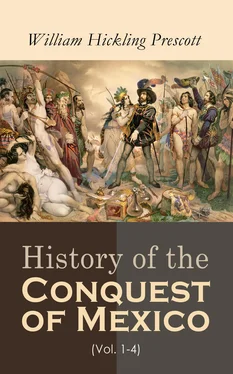He accordingly laid a plan for making away with him at an evening entertainment. It was defeated by the vigilance of the prince’s tutor, who contrived to mislead the assassins and to substitute another victim in the place of his pupil. [270]The baffled tyrant now threw off all disguise, and sent a strong party of soldiers to Tezcuco, with orders to enter the palace, seize the person of Nezahualcoyotl, and slay him on the spot. The prince, who became acquainted with the plot through the watchfulness of his preceptor, instead of flying, as he was counselled, resolved to await his enemies. They found him playing at ball, when they arrived, in the court of his palace. He received them courteously, and invited them in, to take some refreshments after their journey. While they were occupied in this way, he passed into an adjoining saloon, which excited no suspicion, as he was still visible through the open doors by which the apartments communicated with each other. A burning censer stood in the passage, and, as it was fed by the attendants, threw up such clouds of incense as obscured his movements from the soldiers. Under this friendly veil he succeeded in making his escape by a secret passage, which communicated with a large earthen pipe formerly used to bring water to the palace. [271]Here he remained till nightfall, when, taking advantage of the obscurity, he found his way into the suburbs, and sought a shelter in the cottage of one of his father’s vassals.
The Tepanec monarch, enraged at this repeated disappointment, ordered instant pursuit. A price was set on the head of the royal fugitive. Whoever should take him, dead or alive, was promised, however humble his degree, the hand of a noble lady, and an ample domain along with it. Troops of armed men were ordered to scour the country in every direction. In the course of the search, the cottage in which the prince had taken refuge was entered. But he fortunately escaped detection by being hid under a heap of maguey fibres used for manufacturing cloth. As this was no longer a proper place of concealment, he sought a retreat in the mountainous and woody district lying between the borders of his own state and Tlascala. [272]
Here he led a wretched, wandering life, exposed to all the inclemencies of the weather, hiding himself in deep thickets and caverns, and stealing out, at night, to satisfy the cravings of appetite; while he was kept in constant alarm by the activity of his pursuers, always hovering on his track. On one occasion he sought refuge from them among a small party of soldiers, who proved friendly to him and concealed him in a large drum around which they were dancing. At another time he was just able to turn the crest of a hill as his enemies were climbing it on the other side, when he fell in with a girl who was reaping chia ,—a Mexican plant, the seed of which was much used in the drinks of the country. He persuaded her to cover him up with the stalks she had been cutting. When his pursuers came up, and inquired if she had seen the fugitive, the girl coolly answered that she had, and pointed out a path as the one he had taken. Notwithstanding the high rewards offered, Nezahualcoyotl seems to have incurred no danger from treachery, such was the general attachment felt to himself and his house. “Would you not deliver up the prince, if he came in your way?” he inquired of a young peasant who was unacquainted with his person. “Not I,” replied the other. “What, not for a fair lady’s hand, and a rich dowry beside?” rejoined the prince. At which the other only shook his head and laughed. [273]On more than one occasion his faithful people submitted to torture, and even to lose their lives, rather than disclose the place of his retreat. [274]
However gratifying such proofs of loyalty might be to his feelings, the situation of the prince in these mountain solitudes became every day more distressing. It gave a still keener edge to his own sufferings to witness those of the faithful followers who chose to accompany him in his wanderings. “Leave me,” he would say to them, “to my fate! Why should you throw away your own lives for one whom fortune is never weary of persecuting?” Most of the great Tezcucan chiefs had consulted their interests by a timely adhesion to the usurper. But some still clung to their prince, preferring proscription, and death itself, rather than desert him in his extremity. [275]
In the mean time, his friends at a distance were active in measures for his relief. The oppressions of Maxtla, and his growing empire, had caused general alarm in the surrounding states, who recalled the mild rule of the Tezcucan princes. A coalition was formed, a plan of operations concerted, and, on the day appointed for a general rising, Nezahualcoyotl found himself at the head of a force sufficiently strong to face his Tepanec adversaries. An engagement came on, in which the latter were totally discomfited; and the victorious prince, receiving everywhere on his route the homage of his joyful subjects, entered his capital, not like a proscribed outcast, but as the rightful heir, and saw himself once more enthroned in the halls of his fathers.
Soon after, he united his forces with the Mexicans, long disgusted with the arbitrary conduct of Maxtla. The allied powers, after a series of bloody engagements with the usurper, routed him under the walls of his own capital. He fled to the baths, whence he was dragged out, and sacrificed with the usual cruel ceremonies of the Aztecs; the royal city of Azcapozalco was razed to the ground, and the wasted territory was henceforth reserved as the great slave-market for the nations of Anahuac. [276]
These events were succeeded by the remarkable league among the three powers of Tezcuco, Mexico, and Tlacopan, of which some account has been given in a previous chapter. [277]Historians are not agreed as to the precise terms of it; the writers of the two former nations each insisting on the paramount authority of his own in the coalition. All agree in the subordinate position of Tlacopan, a state, like the others, bordering on the lake. It is certain that in their subsequent operations, whether of peace or war, the three states shared in each other’s councils, embarked in each other’s enterprises, and moved in perfect concert together, till just before the coming of the Spaniards.
The first measure of Nezahualcoyotl, on returning to his dominions, was a general amnesty. It was his maxim “that a monarch might punish, but revenge was unworthy of him.” [278]In the present instance he was averse even to punish, and not only freely pardoned his rebel nobles, but conferred on some, who had most deeply offended, posts of honor and confidence. Such conduct was doubtless politic, especially as their alienation was owing, probably, much more to fear of the usurper than to any disaffection towards himself. But there are some acts of policy which a magnanimous spirit only can execute.
The restored monarch next set about repairing the damages sustained under the late misrule, and reviving, or rather remodelling, the various departments of government. He framed a concise, but comprehensive, code of laws, so well suited, it was thought, to the exigencies of the times, that it was adopted as their own by the two other members of the triple alliance. It was written in blood, and entitled the author to be called the Draco rather than “the Solon of Anahuac,” as he is fondly styled by his admirers. [279]Humanity is one of the best fruits of refinement. It is only with increasing civilization that the legislator studies to economize human suffering, even for the guilty; to devise penalties not so much by way of punishment for the past as of reformation for the future. [280]
He divided the burden of government among a number of departments, as the council of war, the council of finance, the council of justice. This last was a court of supreme authority, both in civil and criminal matters, receiving appeals from the lower tribunals of the provinces, which were obliged to make a full report, every four months, or eighty days, of their own proceedings to this higher judicature. In all these bodies, a certain number of citizens were allowed to have seats with the nobles and professional dignitaries. There was, however, another body, a council of state, for aiding the king in the despatch of business, and advising him in matters of importance, which was drawn altogether from the highest order of chiefs. It consisted of fourteen members; and they had seats provided for them at the royal table. [281]
Читать дальше












